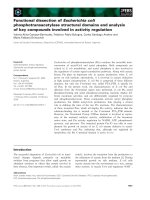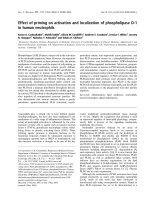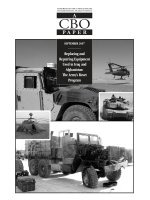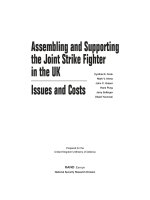Assembling and Supporting the Joint Strike Fighter in the UK potx
Bạn đang xem bản rút gọn của tài liệu. Xem và tải ngay bản đầy đủ của tài liệu tại đây (1.02 MB, 168 trang )
Assembling and Supporting
the Joint Strike Fighter
Cynthia R. Cook
in the UK
Mark V. Arena
John C. Graser
Hans Pung
Jerry Sollinger
Issues and Costs
Obaid Younossi
Prepared for the
United Kingdom
’
s Ministry of Defence
R Europe
National Security Research Division
The research described in this report was prepared for the United
Kingdom’s Ministry of Defence.
Library of Congress Cataloging-in-Publication Data
Assembling and supporting the Joint Strike Fighter in the UK : issues and costs /
Cynthia R. Cook [et al.].
p. cm.
“MR-1771.”
Includes bibliographical references.
ISBN 0-8330-3463-4 (pbk.)
1. X–35 (Jet fighter plane) 2. Short take-off and landing aircraft. 3. Great
Britain. Royal Air Force—Procurement. 4. Great Britain. Royal Navy—
Procurement. 5. X–35 (Jet fighter plane)—Maintenance and repair. I. Cook,
Cynthia R., 1965–
UG1242.F5A72 2003
358.4'383'0941—dc21
2003014692
Cover photograph by Lockheed Martin
RAND is a nonprofit institution that helps improve policy and
decisionmaking through research and analysis. RAND
®
is a
registered trademark. RAND’s publications do not necessarily reflect
the opinions or policies of its research sponsors.
Cover design by Stephen Bloodsworth
© Copyright 2003 RAND
All rights reserved. No part of this book may be reproduced in any
for m by any electr onic or mechanical means (including
photocopying, recording, or information storage and retrieval)
without permission in writing from RAND.
Published 2003 by RAND
1700 Main Street, P.O. Box 2138, Santa Monica, CA 90407-2138
1200 South Hayes Street, Arlington, VA 22202-5050
201 North Craig Street, Suite 202, Pittsburgh, PA 15213-1516
RAND URL:
To order RAND documents or to obtain additional information,
contact Distribution Services: Telephone: (310) 451-7002;
Fax: (310) 451-6915; Email:
PREFACE
In October 2002, the United Kingdom’s Ministry of Defence (MOD)
commissioned RAND to investigate certain issues relating to the pro-
curement of the Joint Strike Fighter (JSF). The MOD plans to procure
up to 150 of the short-takeoff/vertical landing (STOVL) variant of the
JSF to meet its Future Joint Combat Aircraft (FJCA) requirement.
This research was intended to inform the MOD about the overlap
between JSF final assembly and repair, to assess the suitability of four
UK aerospace companies as potential sites for JSF final assembly, to
determine the costs of moving JSF final assembly to the UK, and to
look at certain potential technology transfer–related implications of
such a move.
This book should be of special interest not only to the Defence Pro-
curement Agency and to other parts of the MOD but also to service
and defence agency managers and policymakers on both sides of the
Atlantic. It should also be of interest to aerospace companies in the
United Kingdom. This research was undertaken for the FJCA Inte-
grated Project Team jointly by RAND Europe and the International
Security and Defense Policy Center of RAND’s National Security
Research Division (NSRD), which conducts research for the U.S.
Department of Defense, allied foreign governments, the intelligence
community, and foundations.
For more information on RAND’s International Security and Defense
Policy Center, contact the Director, Jim Dobbins. He can be reached
by e-mail at ; by phone at 703-413-1100,
extension 5134; or by mail at RAND, 1200 South Hayes Street, Arling-
iii
iv Assembling and Supporting the JSF in the United Kingdom
ton, Virginia, 22202-5050. More information about RAND is available
at www.rand.org.
CONTENTS
Preface iii
Figures ix
Tables xi
Summary xiii
Acknowledgements xix
Acronyms xxi
Chapter One
INTRODUCTION
1
History of the Joint Combat Aircraft Requirement
Assess Synergies Between a Repair and
1
History of the Joint Strike Fighter 2
JSF Is an International Collaboration 4
British Aspiration to Repair UK Aircraft 7
Purpose of the Study 9
FACO Facility 9
Examine Potential UK Facilities for JSF FACO 10
Cost Analysis of a UK FACO Facility 10
Questions Regarding the Export of Technology 11
Methodology 11
How This Report Is Organised 11
Chapter Two
AIRFRAME FACO AND AIRFRAME MR&U
13
Background on FACO Processes 13
Background on Aircraft Maintenance 19
v
vi Assembling and Supporting the JSF in the United Kingdom
Organisational Level 20
FACO Processes Compared to Airframe Depot MR&U
Common and Unique Worker Skills and Learning
Potential Advantages of Collocating FACO
Potential Disadvantages of Collocating FACO
Intermediate Level 20
Depot Level 21
Depot Maintenance Costs 24
MR&U Scenarios 30
Processes 32
Overlap of Tooling and Facilities 35
Required 36
and MR&U 39
with MR&U 41
Chapter Three
POTENTIAL SITES FOR JSF FACO OR MR&U IN THE
UNITED KINGDOM 43
The UK Aerospace Industry 43
BAE SYSTEMS 45
DARA 47
Marshall Aerospace 49
Rolls-Royce 51
FACO Facility Requirements 52
Chapter Four
COST ASSESSMENT
57
Methodology
Discussion and Treatment of Individual
57
Which Budget? 57
Overview of the Cost Modelling Approach 58
Model Structure 59
Overall Description 59
General Assumptions 62
Cost Factors 62
Direct Production Labour and Cost 66
Chapter Five
RESULTS OF COST ANALYSIS
85
Introduction 85
Calculating Cost Differences of UK Alternatives 86
Cost Elements 88
Contents vii
Baseline Assumptions 90
The Cost Difference Between Alternatives 90
Sensitivity Analysis 94
Additional FACO Production 94
Extent of MR&U Workload 97
Learning Transfer Percentage 97
Royalty Charge/Licencing Fees 98
Long-Term Exchange Rate 99
Monte Carlo Uncertainty Analysis 100
Summary 102
Chapter Six
JSF TECHNOLOGY-TRANSFER ISSUES 105
Background and U.S. Policy on Military Technology
JSF FACO and MR&U Technologies Affected by
Technology-transfer Negotiations and the JSF Programme
Transfer 106
Arms Export Control Act of 1976 (AECA) 107
ITAR 108
National Disclosure Policy (NDP) 108
Technology-Transfer Process 111
the NDP 112
An Overview of the JSF LO Requirements 113
Manufacturing of JSF Airframe LO Features 114
LO-Related Resources Required During JSF FACO 115
Production Schedule 115
UK Sites’ Experience with TAA Processing 117
Summary 118
Chapter Seven
CONCLUSIONS
119
Overlap Between FACO and MR&U
119
Suitability of UK Sites for FACO 121
Costs for a UK FACO Facility 121
Technology-Transfer Issues 122
Appendix
A. SITE QUESTIONNAIRE 123
B. PRODUCTION GAPS AND RESTARTS 141
Bibliography 147
FIGURES
2.1. Final Assembly and Checkout 14
2.2. Percentage of Total Through-Life Costs Attributable
to Variable Airframe Depot Maintenance
25
2.3. F-15A Airframe Depot Labour Hours and Hours per
Total Aircraft Inventory
27
2.4. F-16A Airframe Depot Labour Hours and Hours per
Total Aircraft Inventory
28
2.5. F-18C/D Airframe Depot Labour Hours and Hours
per Total Aircraft Inventory
29
2.6. Notional Overlap of Facilities, Tooling, and
Equipment Between FACO and MR&U
37
3.1. Location of Selected Aerospace Firms 45
4.1. Cost Model Influence Diagram 61
5.1. Sensitivity of Net Cost Delta to Additional Production
at UK FACO Site
95
5.2. Cost Element Deltas for FACO and MR&U in UK
Versus Baseline as a Function of Additional FACO
Production for Assumption B
96
5.3. Learning Transfer Percentage Sensitivity Analysis 99
5.4. Total Cost Delta Sensitivity to Royalty Fee 100
5.5. Long-Term Exchange Rate Sensitivity for Total Cost
Delta
101
ix
TABLES
S.1. Incremental Cost of Moving JSF FACO to the UK xvi
1.1. JSF International Participation 6
2.1. Cycle Time Required for FACO Activities 18
2.2. Comparison of FACO with JSF Airframe MR&U
Scenarios
33
3.1. Facilities and Other Capabilities for FACO and
Airframe Depot MR&U
54
4.1. Buy Quantities by Fiscal Year Under Different
Scenarios
64
4.2. Investments Required for FACO
(Contractor-Owned)
78
4.3. Investments Required for FACO
(Government-Owned)
79
5.1. Incremental Cost for a Combined UK FACO and
MR&U Site Minus Baseline of All Work Outside UK—
Assumption B
91
5.2. Incremental Cost for a FACO-Only UK Facility Minus
U.S. FACO—Assumption A
92
5.3. Incremental Cost for Adding a UK FACO Facility
Given an Already Planned and Budgeted MR&U
Facility—Assumption C
93
5.4. Incremental Cost for FACO and MR&U in UK Versus
Baseline (Assumption B) with Different MR&U
Assumptions
98
5.5. Average Incremental Cost—Monte Carlo Analysis 102
B.1. Recurring and Nonrecurring Costs Associated with a
Production Gap
142
B.2. Loss of Learning Impacts of a Production Gap 144
xi
SUMMARY
BACKGROUND AND PURPOSE
The Ministry of Defence (MOD) of the United Kingdom (UK) has
selected the short-takeoff/vertical landing (STOVL) variant of the
U.S. Joint Strike Fighter (JSF) as the replacement for its Harrier air-
craft. Current plans call for the UK to procure up to 150 aircraft at a
potential cost of up to £10 billion (then-year £). The MOD also wants
to develop a capability to maintain, repair, and upgrade its JSFs,
which would require investments in facilities, equipment, and labour
force. Because many of these capabilities apply to the final assembly
and checkout (FACO) of the aircraft, the question arises about what
such investments would imply for the cost-effectiveness of perform-
ing JSF FACO in the UK.
The UK MOD asked RAND Europe to address this question. Specifi-
cally, it asked RAND to accomplish the following:
• Assess synergies between a repair and FACO facility.
• Examine potential UK facilities for JSF FACO.
• Analyse the cost of a UK FACO facility.
• Consider issues regarding the export of technology.
RESULTS OF ANALYSIS
The results of our analyses are as follows.
xiii
______________
xiv Assembling and Supporting the JSF in the United Kingdom
Synergies Between Repair and FACO
FACO and maintenance, repair, and upgrade (MR&U) tasks overlap.
Advantages and disadvantages of doing both activities differ,
depending on whether the activities take place at the same location
or are divided between two. The advantages of carrying out both
activities in the same location include an easier transition from
FACO to MR&U, a smaller engineering workforce, and a potential to
adjust and level workload more easily. The FACO manufacturing
space and tooling could also be used for MR&U, which could reduce
total required investments. Additionally, technical support could be
consolidated at one site. Disadvantages include the need to manage
two processes rather than one and the possibility that the unpre-
dictable nature of MR&U work might interfere with FACO activities.
Dividing FACO and MR&U could enable the MOD to open future
repair work to competition, possibly leading to lower costs and
higher efficiency. Two sites would broaden the aircraft industrial
base and reduce the susceptibility of both processes to influence by
such local issues as concerns about aircraft arrivals and departures.
Potential Facilities
The MOD suggested four sites as potential locations for FACO or
MR&U. In alphabetical order, these are BAE SYSTEMS, the Defence
Aviation Repair Agency (DARA), Marshall Aerospace, and Rolls-
Royce. We conclude that three of the four sites could carry out either
process, although their different existing facilities and capabilities
mean that different levels of investment would be required at each
site to enable JSF FACO. We eliminated Rolls-Royce as a candidate
largely because the company’s strategic focus on propulsion means
that it does not have the facilities or past experience in airframe
assembly, maintenance, or overhaul to host JSF FACO.
Cost
1
What would it cost to establish a JSF FACO facility in the UK? To
protect the business sensitivity of the cost data, we present our
1
The cost figures are reported in FY 2003 £, undiscounted.
______________
Summary xv
results as the incremental cost of assembling the JSF at a UK location
compared with the same aircraft assembled at Lockheed Martin’s
Fort Worth, Texas, plant. In other words, ‘How much more will it
cost the UK?’ (Note that the baseline costs for FACO of the UK air-
craft in the United States are approximately £112 million [FY 2003].
2
)
This difference is determined by comparing estimates of the FACO
portion of the work done in Fort Worth and the UK, including how
moving that work affects certain other costs (described below). We
then report the average (arithmetic mean) result over all three UK
sites.
There are three possible scenarios for establishing a JSF FACO facility
in the UK:
• FACO Only—A FACO facility is established in the UK indepen-
dent of an MR&U facility. This is also the case where there is
negligible MR&U work for the JSF.
• Combined Facility—Both FACO and MR&U are done for the JSF
in a combined facility. Initially, the facility produces the JSF and
eventually makes the transition to an MR&U facility. Therefore,
FACO investments could be reused for MR&U, reducing the cost
of MR&U activities.
• FACO Added to an Existing JSF MR&U Facility—FACO activities
are added to a planned and fully funded UK JSF MR&U facility.
This approach assumes that common facilities, equipment, and
tooling would be acquired earlier than needed for MR&U work;
thus enabling FACO activities. This scenario is somewhat con-
trived because it reflects neither the actual sequence of decisions
that would have to occur nor the way that the money would be
spent. The FACO facility would have to be established before the
maintenance depot.
The main difference between the last two scenarios is the baseline
against which the incremental costs are calculated. The baseline for
the second scenario does not include any UK work. The incremental
costs for this include the total cost effects from putting a combined
2
This value encompasses several assumptions, among which is a constant exchange
rate of $1.61 = £1, which is based on an annual average from the past 16 years, the
period for which data were readily available in electronic form.
______________
xvi Assembling and Supporting the JSF in the United Kingdom
FACO and MR&U facility in the UK. The baseline for the third sce-
nario incorporates the costs of an MR&U facility. The incremental
costs for this include only the cost effects of moving FACO to an exist-
ing MR&U facility. The total cost to the UK for FACO and MR&U
activities is the same in both cases.
To facilitate cost comparisons, we break them into four components:
(1) the FACO costs themselves—the actual incremental cost of mov-
ing FACO from the United States;
3
(2) the effect on UK MR&U costs
for the JSF if FACO work is performed at the same site; (3) the effect
on other JSF component costs (i.e., the forward and aft fuselage, the
wings, and the tail) caused by moving FACO away from Fort Worth
and to a UK site, thereby reducing work at Fort Worth and increasing
the overhead rate there; and (4) the effect of adding FACO to other
(non-JSF) MOD work being done at a UK site, thereby affecting the
overhead rate for the other programmes.
4
The total effect of the
decision to move JSF FACO to the UK needs to incorporate all of
these costs and not simply the cost of FACO activities. Table S.1
shows the incremental costs for each scenario.
5
Table S.1
Incremental Cost of Moving JSF FACO to the UK (FY 2003 million £)
C
B FACO Added to
A Combined an Existing JSF
Cost Component FACO Only Facility MR&U Facility
FACO costs 34.7 35.6 35.6
MR&U 0.0 –10.0 –10.0
JSF components 1.4 1.4 1.4
Other MOD programmes 10.8 5.7 –14.1
Net Total Costs 46.8 32.7 12.9
3
This includes the additional required facilities, tooling, and equipment; differences in
labour and overhead rates; any royalty costs or licencing fees for technology transfer;
costs of other support Lockheed Martin would provide; and a number of other cost
components.
4
These other programmes vary by location.
5
The assumptions that led to these estimates are discussed in greater detail in the
report, along with tests of the sensitivity of the results to changes in the assumptions.
Summary xvii
Not surprisingly, Table S.1 shows that establishing a FACO-only facil-
ity has the greatest incremental costs. A combined facility reduces
the incremental cost by nearly a quarter through savings in MR&U
investments and a general reduction in overhead rates. The last sce-
nario shows that the incremental investment to add FACO to an
existing JSF MR&U facility is quite modest. (Total costs to the MOD
are the same for B and C, but the MR&U investments for C are
treated as ‘sunk costs’, providing the marginal cost for FACO.)
Another caution is that the airframe MR&U concept for the JSF has
not been fully defined. Therefore, true costs and the exact require-
ments for MR&U are unknown. The most conservative approach in
estimating the possible costs to the MOD for a UK JSF FACO site
would be to assume the FACO-only scenario (+£47 million).
Technology Transfer
For a UK site to carry out JSF FACO, certain technologies must be
transferred from the United States to the United Kingdom. This pro-
cess is complex and bureaucratic. When the transfer involves classi-
fied technologies, as the JSF does, the process becomes even more
complicated and can take a long time. This issue becomes particu-
larly important when the timelines of the JSF are taken into account.
A FACO facility needs to be in place by the end of 2009, and we esti-
mate that this will take two years to construct. No organisation
would build such a facility without knowing that the transfer of the
technology had been approved. Therefore, the transfer process must
be completed by the latter part of 2007 at the latest. The process is
complex, and the complexity makes the timing unpredictable. Thus,
this issue merits immediate attention.
CONCLUSIONS
We conclude that FACO and airframe MR&U activities and invest-
ments overlap, so the potential for synergies is significant. Any of
three UK facilities evaluated could carry out both processes with dif-
ferent required levels of additional investment and capability devel-
opment. The mean incremental costs range from about £33 million
for a combined, collocated facility to about £47 million if MR&U is
not collocated or if no MR&U is required. If the UK MOD decides to
create a domestic airframe MR&U facility for the JSF and fully factors
xviii Assembling and Supporting the JSF in the United Kingdom
these costs into its plans, the incremental cost to add FACO produc-
tion is about £13 million. Technology transfer issues are complicated
and require resolution before funds are spent to establish either
FACO or MR&U facilities. These issues need to be resolved no later
than 2007.
We finally note that military aircraft programmes have historically
changed during system development and demonstration (SDD).
Typically, aircraft design, weight, and procurement plans all change.
Any such changes would affect the results of our analysis, which is
based on data collected primarily just before SDD began.
ACKNOWLEDGEMENTS
Many individuals in the UK MOD provided their time and their
knowledge to help us perform the analyses presented in this book.
This work could not have been undertaken without the support of
the Future Joint Combat Aircraft Integrated Project Team. The busi-
ness manager, Ken Furber, and the commercial manager, Gavin
Maw, were particularly helpful in providing guidance and informa-
tion, and in helping us collect data from the UK organisations con-
sidered in this study. Commodore Simon Henley, Group Captain
Mark Green, and David Gordon also provided assistance and
insights.
Many people at different UK organisations provided assistance to
this study. We are indebted to Gareth Brogan at BAE SYSTEMS,
David Searle at the Defence Aviation Repair Agency, Eddie MacLean
at Marshall Aerospace, and Andrew Hirst at Rolls-Royce. Each
organised a response to our lengthy questionnaire, and hosted us for
a visit to their facilities. We also thank their many colleagues who
participated in data collection and in the meetings.
Lorraine Johnson, at the UK Department of Trade and Industry,
provided further insight into the aerospace sector of the UK econ-
omy. Linda Lloyd of the Society for British Aerospace Companies
helped us contact companies in the broader UK aerospace industrial
base to collect their perspectives.
In the United States, Col. Tony Romano of the JSF Program Office
provided the U.S. perspective, as well as guidance and friendship
through the course of the study. We wish him well in his next
assignment.
xix
xx Assembling and Supporting the JSF in the United Kingdom
This work relied on data by Lockheed Martin provided for an earlier
research effort, which were reused with the company’s permission.
Larry McQuien was instrumental in assisting us for the first study.
Jim O’Neil provided updates and additional data in support of this
effort.
At RAND, Michele Anandappa provided both research assistance and
administrative support. The skillful editing of Dan Sheehan greatly
improved the readability of this report.
We particularly would like to thank our three reviewers, William
Stussie and RAND colleagues Michael Kennedy and Frank Lacroix.
Their careful and constructive comments substantially improved this
report.
CV
ACRONYMS
AECA Arms Export Control Act
ASTOVL Advanced short-takeoff and vertical landing
BUR Bottom-Up Review
C4ISR Command, Control, Communications, Computers,
Intelligence, Surveillance, and Reconnaissance
CAD/CAM Computer-aided design/computer-aided
manufacturing
CALF Common Affordable Lightweight Fighter
CDP Concept demonstration phase
CLS Contractor logistics support
CMI Classified military information
CTOL Conventional takeoff and landing
Carrier variant
CVF Carrier version future
CVS Carrier version strike
DARA Defence Aviation Repair Agency
DARPA Defense Advanced Research Projects Agency
DoD Department of Defense
DTI Department of Trade and Industry
DTSI Defense Trade Security Initiative
ECA Enhanced Capital Allowance
ECS Environmental Control System
xxi
xxii Assembling and Supporting the JSF in the United Kingdom
EO/IR Electro-optical/infrared
FACO Final assembly and checkout
FCBA Future Carrier-Borne Aircraft
FCCM Facilities Capital Cost of Money
FJCA Future Joint Combat Aircraft
FMS Foreign military sales
FTE Full-time equivalent
G&A General and administrative
GAO General Accounting Office
GPA Global Project Authorization
GSA General Security of Military Agreements
ICS Interim contractor support
IPT Integrated project team
ITAR International Traffic in Arms Regulations
ITL Incomplete task log
JAST Joint Advanced Strike Technology
JCA Joint Combat Aircraft
JSF Joint Strike Fighter
LO Low observable
LOA Letter of offer and acceptance
MLA Manufacturing Licence Agreement
MOD Ministry of Defence
MOU Memorandum of understanding
MR&U Maintenance, repair, and upgrade
MRF Multirole fighter
NDP National Disclosure Policy
NDPC National Disclosure Policy Committee
NSDM National Security Decision Memorandum
OBIGGS On-Board Inert Gas–Generating System
OBOGS On-Board Oxygen-Generating System
Acronyms xxiii
ODTC Office of Defense Trade Controls
OEM Original equipment manufacturer
ORD Operational requirements document
PAA Primary aircraft authorisation
QMAC Questionnaire on Methods of Allocation of Costs
R&R Remove and replace
RAF Royal Air Force
RAM Radar-absorbing material
RAS Radar-absorbing structure
RCS Radar cross section
RF Radio frequency
RN Royal Navy
SBAC Society of British Aerospace Companies
SCP Security cooperation participation
SDD System development and demonstration
STOVL Short-takeoff/vertical landing
TAA Technical assistance agreements
TAI Total active inventory
URF Unit recurring flyaway (cost)
USAF U.S. Air Force
USMC U.S. Marine Corps
USML U.S. Munitions List
VAT Value-added tax
VOC Volatile organic compound
WBS Work breakdown structure
______________
Chapter One
INTRODUCTION
HISTORY OF THE JOINT COMBAT AIRCRAFT
REQUIREMENT
1
In 1996, the United Kingdom began the formal procurement process
to examine options for a Future Carrier-Borne Aircraft (FCBA) to suc-
ceed the Royal Navy’s Sea Harrier in 2012. The 1998 Strategic
Defence Review White Paper confirmed that the Royal Navy (RN)
and Royal Air Force (RAF) Harrier forces would be combined into a
new Joint Force 2000. After this, the FCBA requirement was widened
to include replacement of the RAF’s GR.9 and T10 ground-attack
Harriers around 2015, thus providing the UK with a joint land- and
sea-based expeditionary air-power capability. To reflect this change,
the programme was renamed Future Joint Combat Aircraft (FJCA) in
2001. FJCA is to replace current Joint Force Harriers with a multirole
fighter-attack aircraft, on approximately a one-for-one basis.
The U.S. Joint Strike Fighter (JSF) has been identified as having the
best potential to meet the requirement, resulting in the signing in
January 2001 of a memorandum of understanding (MOU) that called
for the UK to enter the system development and demonstration
(SDD) phase of the JSF programme as a Level I partner (see below for
definition). The UK has committed some £1.4 billion to the JSF pro-
gramme. This occurred after successful UK participation in the con-
1
History from
1
______________
2 Assembling and Supporting the JSF in the United Kingdom
cept demonstration phase (CDP
2
) of the JSF programme, which
involved development and test flights of the Boeing X-32 and the
Lockheed Martin X-35. This flight test programme supported the JSF
source-selection process, which included an extensive assessment of
the ability of each contractor to develop and deploy a family of
advanced strike aircraft to meet the requirements of the U.S. Air
Force, Navy, and Marine Corps and the UK Ministry of Defence
(MOD) FJCA programme. Following the conclusion of this source-
selection process, it was announced in October 2001 that Lockheed
Martin had been selected as prime contractor to take the programme
forward. The UK participated in the source-selection process.
On September 30, 2002, the UK announced that the short-take-
off/vertical landing (STOVL) variant of JSF had been selected to meet
its requirements, in preference to the carrier variant (CV). The total
procurement cost to the UK may be as high as £10 billion.
3
HISTORY OF THE JOINT STRIKE FIGHTER
The JSF emerged from technology and aircraft development efforts
in the early 1990s as a joint aircraft designed to meet the long-term
air-to-ground needs of the three U.S. services that operate strike air-
craft. It originated from several previous aircraft programmes. In
1983, the Defense Advanced Research Projects Agency (DARPA)
began a project examining an advanced short-takeoff and vertical
landing (ASTOVL) capability. This was established as a joint U.S UK
programme in 1986, when the two countries signed an MOU. (A sec-
ond MOU was signed in 1994 after the 1986 MOU had expired.) In
1991, the U.S. Navy began planning efforts for the two-engine, tech-
nologically complex Advanced Attack/Advanced Attack Fighter (A-X
or A/F-X) meant to replace the A-6, in lieu of the cancelled A-12 pro-
gramme. Also in 1991, the U.S. Air Force (USAF) multirole fighter
(MRF) was conceived as a relatively inexpensive single-engine
replacement for the F-16.
2
In this report, we follow U.S. Department of Defense (DoD) acquisition terminology
for ‘CDP’, using it to refer to the JSF programme phase leading up to source selection.
In the UK, ‘CDP’ is the Chief of Defence Procurement.
3
______________
3 Introduction
In 1993, the U.S. Department of Defense (DoD) initiated a Bottom-
Up Review (BUR) of DoD forces and modernisation plans. Recom-
mendations for aviation included the cancellation of the A-X and
MRF programmes, curtailment of the F-16 and F/A-18C/D pro-
grammes, and the beginning of the Joint Advanced Strike Technol-
ogy (JAST) programme.
4
JAST goals included the development of a
joint aircraft with advanced technologies but with reduced life cycle
costs. Within the next year, more work was consolidated into the
effort; including the DARPA Common Affordable Lightweight Fighter
(CALF) programme.
5
The aircraft derived from JAST programme technology, as a next-
generation multimission aircraft, was planned to replace and aug-
ment a number of other aircraft for different services. For the United
States it was planned to replace USAF F-16s and A-10s and comple-
ment the F-22; augment carrier-based U.S. Navy (USN) F/A-18E/Fs,
and replace U.S. Marine Corps (USMC) AV-8Bs and F/A-18C/Ds. It
was also planned to replace RAF and RN Harrier aircraft.
In December 1994, four companies—Boeing, Lockheed Martin,
McDonnell Douglas, and Northrop Grumman—were awarded 15-
month concept definition and design research contracts. Northrop
Grumman, McDonnell Douglas, and British Aerospace then agreed
to form a team. After various programme reviews, Boeing and Lock-
heed Martin won concept demonstration phase prime contracts in
November 1996. Boeing then merged with McDonnell Douglas,
while Lockheed Martin began working with Northrop Grumman and
British Aerospace (later, BAE SYSTEMS). By this time, the pro-
gramme had been renamed the JSF.
After five years of the CDP, on October 26, 2001, DoD awarded the
SDD contract of almost $19 billion to the Lockheed Martin team as
the final step in the winner-take-all competition.
6
When completed, the JSF programme will be one of the largest air-
craft acquisition programmes in U.S. history, worth some $300 bil-
4
www.jsf.mil.
5
www.jsf.mil.
6
A description of the announcement can be found at
news/Oct2001/b10262001_bt543-01.html.
______________
4 Assembling and Supporting the JSF in the United Kingdom
lion (then-year dollars) over the next quarter-century. The aircraft
will be produced in three configurations—a conventional takeoff and
landing (CTOL) variant, a STOVL variant, and a CV.
The original acquisition plans called for the USAF to buy 1,763 CTOL
aircraft. The USN was to buy 480 of the CV aircraft, and the USMC
was to buy 609 STOVL aircraft. (More recently, the combined USN
and USMC buy was reduced by 409 aircraft,
7
although this informa-
tion became available too late to be included in the cost analysis
described in this report.) To meet its FJCA requirement for the RN
and RAF, the UK MOD will procure up to 150 STOVL variant JSF air-
craft. It is estimated that other nations could purchase an additional
3,000 aircraft. Indeed, a number of countries have already commit-
ted to participating in the programme.
JSF IS AN INTERNATIONAL COLLABORATION
As a ‘collaborative development partner’, the UK has been given
more insight into the programme than is typical in a foreign military
sales (FMS) agreement and in fact has input into the air system, par-
ticularly the STOVL variant design. The UK Operational Concept,
part of the JSF operational requirements document (ORD) of March
2000, lays out a vision for commonality with the following state-
ment:
8
The principal missions of the UK will be day and night adverse
weather, anti-air attack and reconnaissance operations from Main
Operating Bases (MOB), other airfields, austere bases, Carrier Ver-
sion Strike (CVS) and Carrier Version Future (CVF) carriers. Sorties
will be preplanned or alert status and comprise pair package for-
mations. Warlike operations will not be normally conducted as
singletons and may range from self-escort autonomous operations
to those requiring detailed integration and data linking to other C4I
entities including air and surface units. Through air-to-air refueling
(probe and drogue) and/or the carriage of external drop tanks,
future air commanders will be provided with operational flexibility.
7
8
JSF ORD signed in March of 2000.
______________
5 Introduction
Through commonality with USMC, the UK seeks to maximize the
potential for combined operations.
One goal of the JSF programme is to create a new model for interna-
tional collaboration that provides specific entry and exit criteria for
the programme’s non-U.S. participants. This model allows individ-
ual countries enough insight into the programme to decide whether
the JSF is the right platform for their national security needs. They
are also allowed to use JSF modelling and simulation technologies to
validate their requirements.
The degree of involvement of each country is determined by the level
of their investment in the programme. There is a formal structure
that includes four possible levels of partnership:
9
Level I Partners (collaborative development partners) have signifi-
cant access to most aspects of the programme as well as the ability to
influence requirements and the design solutions. The UK is the only
nation in this category. The total UK funding contribution makes up
about 10 percent of the SDD budget. The UK has 10 staff members
fully integrated in the programme office. The development nonre-
curring recoupment charges are waived for the UK, and they will
receive a share of the levies on sales to third parties. (The purpose of
these levies is a partial distribution of the development costs to those
nations who did not contribute towards the cost of JSF SDD.)
Level II Partners (associate partners) have limited access to the core
programme and technologies. Italy and the Netherlands are in this
category. Their funding contribution is about 5 percent of the SDD
budget each. They will receive a proportional share of levies on sales
to third parties. These partners are allowed to have three to five staff
members integrated into the programme office.
Level III Partners (informed partners) are provided enough infor-
mation to evaluate the utility of the JSF family for their specific
needs. Australia, Canada, Denmark, Norway, and Turkey fall in this
category. Their funding contribution ranges from 1 to 2 percent of
the SDD phase. They will receive a proportional share of levies on
sales to third parties. The office representation is limited to one
9
Information largely based on the JSF website at www.jsf.mil.









